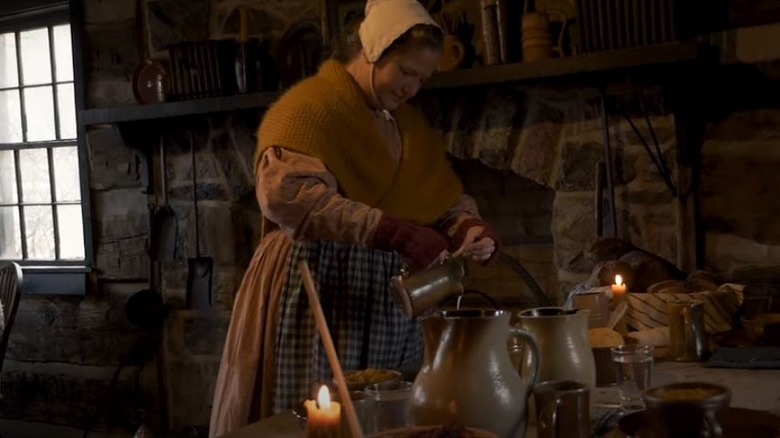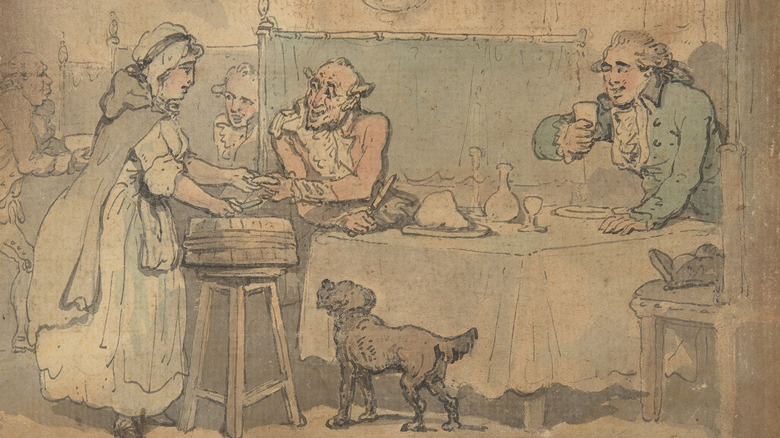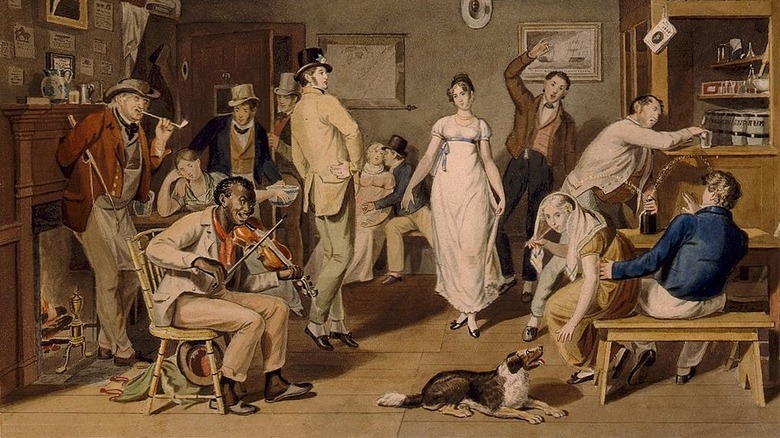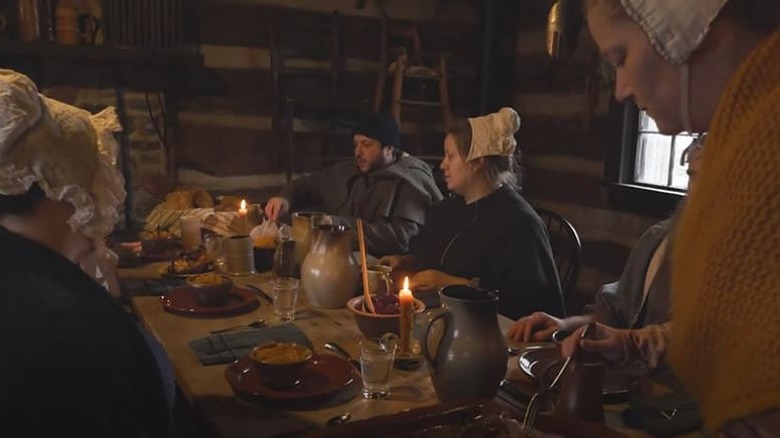What Life Was Like As A Tavern Keeper In The Colonial Era
Colonial taverns started as places for the adults (especially men) to congregate for a drink. And the colonists certainly didn't shy away from them, especially since at the time water, was often contaminated and considered unhealthy to drink. Throughout the colonies, rum was the main drink served in taverns, though beer and hard cider were also popular choices (per Historic Taverns and Tea Rooms of Maine).
As part of their daily work, tavern keepers also prepared their own "mixed drinks," and some taverns were famous for the variety they offered. A very popular colonial alcoholic drink was the flip, which is made by mixing strong beer, rum, and some sort of sweetener like molasses or dried pumpkin. Tavernkeepers will then put on a bit of a show for their patrons by dropping a hot iron loggerhead inside the pitcher, causing the mix to foam and acquire its characteristic burnt flavor. According to Historic Taverns and Tea Rooms of Maine, other tavernkeepers offered punch, made using a number of ingredients — including tea, rum, spices, fruit juices, and lots of sugar — and served in large containers that were part of the attraction.
While some taverns were almost exclusively the dominion of men, others would cater to families by offering child-friendly drinks (which would be light cider – no water for the kids, either) and even musical entertainment (via The Gettysburg Historical Journal).
Taverns were more than just places to grab a drink
Welcoming families into the tavern kept the place trouble-free and kept away gamblers (gambling was illegal in taverns) and those looking for a rowdy place to drink. Over time, tavernkeepers saw an opportunity to expand by offering space in their establishments for social, religious, and political meetings, and taverns became gathering spaces for the community. Entrepreneuring tavern keepers also rented space as a courtroom and sometimes kept convenience stores and even post offices on the premises (via The Gettysburg Historical Journal). This was especially important in smaller and newer colonies that didn't yet have dedicated buildings for each of these things.
Larger taverns also offered rooms where long-distance travelers could spend the night. These taverns tended to be more upscale, offering large lounging areas around a fireplace, a dedicated dining area, and sometimes even a different parlor room for the women so they could spend time in a quieter area. Some even became popular entertainment venues. In the March 1752 issue of the Virginia Gazette from Colonial Williamsburg, a post announced, "For the LADIES and GENTLEMEN, There will be a BALL, at Henry Wetherburn's Tavern on Tuesday Evening next, the 10th instant, and on every Tuesday during the sitting of the General Assembly," as published on Slavery and Remembrance.
About two-thirds of tavern keepers in colonial America were women
Women made up the majority of tavern keepers in colonial America — a perhaps surprising fact in a century when women still did not have enough freedoms to pursue many other jobs. In order to run a tavern, one needed a license. And magistrates, it seems, were particularly open to giving one to widows and middling white Virginia women, according to Early American Studies: An Interdisciplinary Journal. Many women also inherited taverns from their deceased husbands, as they were allowed to continue running the business under the same license.
Tavern keeping was one of those career choices that would pass on from mothers to daughters, just as manual trades (from welding to farming) would usually pass from fathers to sons. According to The Gettysburg Historical Journal, tavern keepers often received incentives to run their business — anything from tax exceptions to land grants. Magistrates were also more likely to give a tavern license to families with good financial means. Running a tavern wasn't cheap, so a family with money and a good social standing were less likely to fail and more likely to keep the tavern going, which was essential for the community.
According to the Mariners Museum, the first female tavern-keeper in Colonial America was widow Alice Thomas, who ran a tavern in Boston in the 1670s. Although she was arrested at one point for selling alcohol without a license and letting people use her property to "commit carnale wickedness," she had enough money to pay her way out of trouble.
Days as a tavern keeper were long, hard, and often dirty
Many taverns opened very early to provide food for laborers and seamen before they started their days, though formal breakfast was served at 9 a.m., according to Colonial London Town. Breakfast was often the heartiest meal of the day, filled with plenty of meats, bread, and coffee or tea. While the tavern keeper would be up and supervising the goings of the business, she (or sometimes he) likely had workers helping in the kitchen. For harder manual labor, the colonies also had slaves, National Geographic reports. While slaves in the South worked on plantations and farms, those in the northern states were essentially servants, helping keep up homes and businesses, including taverns.
Tavern help extended throughout the day, as the establishments would serve lunch at around 2 p.m. and then dinner (or supper) at 7 p.m. To make things easier, taverns would sometimes prepare one main meal (such as a roast or soup) that would then be served for both lunch and dinner with a few side dishes. Salted fish, peas, eggs, and sliced cabbage were often part of tavern meals. These were all quick and easy to prepare, leaving more free time for the tavern keeper and the helpers to attend to other business matters. After supper, the tavern keeper would supervise events organized at the establishment, including dancing balls, meetings and discussions, or traveling shows such as musicians or carnivals (per The Gettysburg Historical Journal).



